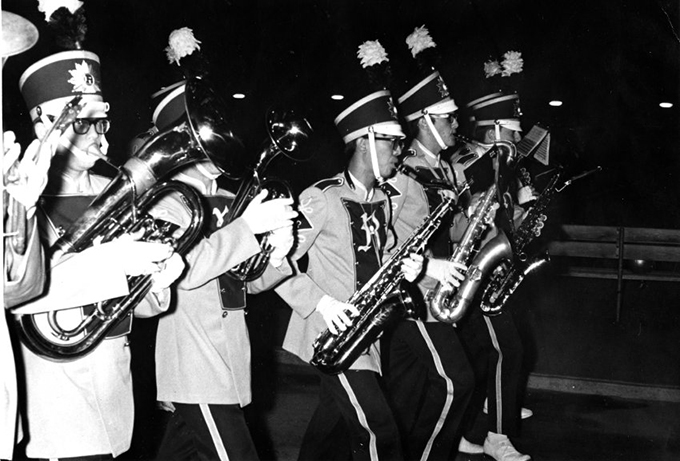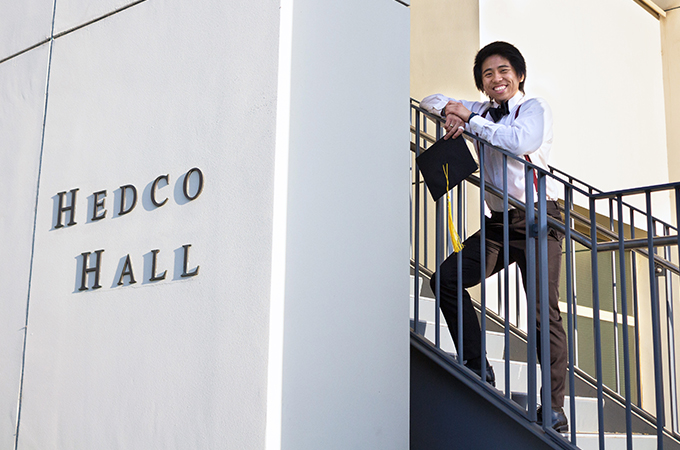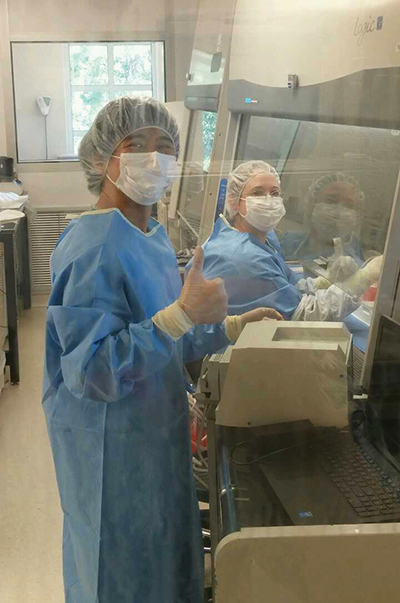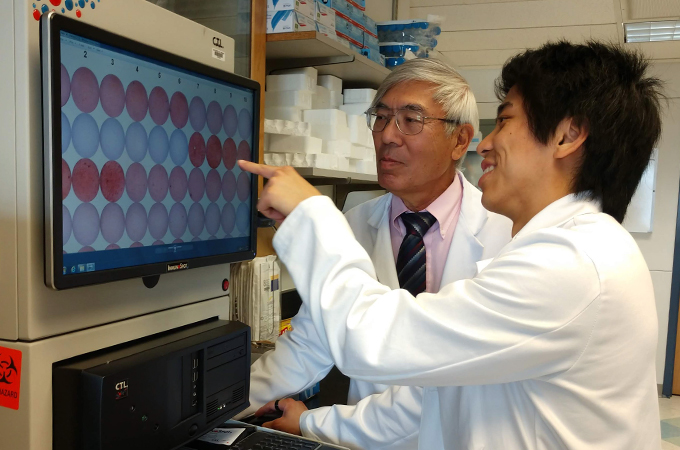Despite having graduated decades apart, two University of Redlands alumni, Lawrence (Larry) Lum ’69, M.D., D.Sc., and Johnson Ung ’17, are on the same mission to cure cancer. The scientists are working together to conduct groundbreaking research at the University of Virginia in Charlottesville.
But how did these Bulldogs manage to cross paths nearly 2,500 miles away from the U of R?
From music to medicine
The story begins in Sacramento, California, where Lum grew up in the 1950s. A young boy with asthma and allergies, Lum was unable to expend all his energy outside, so his father began teaching him piano. He started taking lessons from a retired Chicago Philharmonic concert master, who also taught him clarinet and violin. After his father began attending a Chinese Northern Baptist Missionary Church, Lum eventually became the church’s pianist and choir master.
Lum ended up at the U of R when the Northern American Baptist Convention—which was then associated with the University—awarded him a full scholarship. At the same time, he won the California Bank of America Music Award. But, surprisingly, Lum was never a music major.
“I sang in the chapel choir; I was in the Chapel Singers; and I was involved in Feast of Lights in ’66, ’67,” Lum recalls. “I played saxophone in the U of R marching band, jazz band—but I was a chemistry major.”

At the beginning of his undergraduate studies, Lum wanted to become a medical missionary. While his path evolved, his goal for making a difference in medicine, particularly for patients with cancer, has remained constant since high school.
Influential mentors
At the U of R, Professors of Chemistry Julian Roberts and James (Jim) Ifft were major influences. “They really believed in independent study and were very interactive, very available, and got us involved in summer research,” says Lum. “I did summer research every single summer, and began doing independent study my sophomore year. During the summers, Jim, besides making us write our own summer grants to be funded by the National Science Foundation, would run a P.E. class where you had to hike in the High Sierras, tie your own flies, and catch trout.” Lum, who is still an avid fly fisherman to this day, graduated magna cum laude and was subsequently inducted into Phi Beta Kappa.
Later, when Lum was a first-year medical student at University of California, San Francisco, he traveled to Copenhagen to complete his summer fellowship research with Ifft, who was on sabbatical. “I worked in the Carlsberg laboratory, which was an inspiration because three Nobel Prize winners had done their work there,” says Lum. “I ended up in a couple of papers.”
“If it weren’t for Jim,” Lum emphasizes, “I would not be where I am now.”
It would be years later, in 2000, that Lum would make a special trip back to the U of R to be presented with an honorary Doctor of Science.
By his third year of medical school, which he completed at the University of Colorado, Lum wanted to be a pediatric immunologist and study children born with no immunity. He conducted research at the National Cancer Institute before becoming a member of the premier bone marrow transplant program at Fred Hutchinson Cancer Research Center in Seattle during the pioneering days of stem cell transplants. Lum, with 85 publications under his belt, became a full professor in only six years. This feat is even more impressive considering that he and his wife, Carol, who graduated with a degree in biochemistry from University of California, Berkeley, were both working and raising two young daughters at the time.
It was in 1995 when Lum was working as part of a stem cell transplant program in Milwaukee, Wisconsin, that bispecific antibody armed-targeted T cells began to emerge. T cells are a type of white blood cell that play a major role in the immune system, and Lum’s goal was to figure out how to engineer them to kill cancer.
“That’s when we started putting together targeted T cells and a little bit of science,” says Lum.
A broad foundation
During that same decade, several states away in California, Johnson Ung was growing up in Yucaipa, just minutes away from the University of Redlands campus.
Ung admits that while Redlands wasn’t originally at the top of his list of prospective schools due to his desire to put some distance between himself and his hometown, he changed his mind when he “immediately fell in love” during a tour of campus.
Upon beginning his academic journey at Redlands, Ung was certain of his goal to become a clinical investigator, but unsure of the best way to achieve it. Ung ultimately pursued a B.S. in chemistry and biology, basing his decision not only on his desired career path, but also on his intellectual curiosity. “I chose to double major because I wanted to have a better understanding of how nature functions, with the ultimate goal of turning science into therapy,” says Ung. “Research is often plagued by tunnel vision, and I felt a broader skillset was the necessary foundation.”
On top of earning summa cum laude and being inducted into Phi Beta Kappa, Ung was involved in a multitude of organizations during his time at Redlands, including Omicron Delta Kappa, a leadership honor society; Mortar Board, an honor society for seniors; Phi Sigma, a biological sciences honor society; and Rangi Ya Giza, a non-Greek social justice brotherhood. For two years, Ung served as a peer advisor for Professor of Philosophy Lawry Finsen’s first-year seminar, Beyond the Killing Fields: Encountering Cambodia Today, which allowed him to be a student advisor for the associated May Term travel course, Service in Cambodia, following his graduation. And, like Lum, Ung was bitten by the music bug, having played trumpet in high school and French horn in the U of R symphonic band. He also plays piano and dabbles in the ukulele.

It was Professor of Biology Ben Aronson who introduced Ung to the world of clinical research. “He recommended an outstanding internship opportunity at Seattle’s Fred Hutchinson Cancer Research Center,” says Ung. “Without Dr. Aronson, I probably would not be on the same career path that I am today.”
Taking the leap
About one year after Lum began working as the scientific director of bone marrow transplantation and director of cellular therapy at the University of Virginia Cancer Center, Ung joined Lum’s lab as an intern and was then hired on as a clinical research technician.
Ung says moving across the country was “simultaneously one of the scariest and most exciting things” he has ever done. He admits that working with Dr. Lum and his group was nerve-wracking at first, but, over time, Ung eased into his job and found a sense of belonging. “I feel like an important part of the whole operation,” he says.
His place in the operation includes working with those special T cells.
First, T cells are collected from the patient and cultured to increase their population from 10 billion to 100 billion. The T cells are then coated with a bispecific antibody, which attaches to the T cell on one end and is directed to a tumor-associated antigen (a part of the tumor that can be recognized by the immune system) on the other.
“The usual frequency of killer cells directed at the tumor is very low—about 1 in 1 million,” says Lum. “So, when we infuse the targeted army into the patient, we’re putting in a huge magnification of cells ready to target and destroy. The whole idea is to turn every single T cell that we obtain from the patient into an army of killers all targeted at the same tumor.”
When the bispecific antibody armed-targeted T cells (BATs) come into contact with the tumor, they release immune proteins that recruit surrounding immune cells to the tumor site, where they also learn to attack the tumor. “The BATs are the kamikazes that attack the tumor to release the tumor antigens,” Lum explains. “The endogenous fresh immune cells of the patient are now able to sense the tumor, divide, and make more of themselves. Infusions of BATs vaccinate the patients against their own tumors. We now have data in cancer patients—prostate, breast, and pancreatic cancers, along with blood disorders such as non-Hodgkin’s lymphoma and multiple myeloma in combination with stem cell transplant—showing immunological memory is induced by an infusion or multiple infusions of BATs.”
Lum, who holds all the patents and intellectual property linked to the BATs, runs the only lab in the world doing this type of immunotherapy. “We’re trying to get the drug in a clinical trial to pave the way for approval by the FDA. We’re trying to make it all the way from discovery to the bedside.”
Paths forward
Finding a cure for cancer isn’t the only thing on Lum’s plate, however. Three principal investigators, including Lum, recently received a $17 million grant for an operation to develop new technology to cure patients with type 1 diabetes. “We are trying to make regulatory T cells that would shut down the autoimmune reactions of pancreatic islet cells,” Lum explains. “We’re trying to modify the patient’s immune system.”

And Ung is spearheading the charge.
A standard day of research for Ung consists of growing, maintaining, and preparing a variety of cells for different experiments. In terms of clinical work, Ung says, “A typical day could involve donning surgical gowns, surgical gloves, hair nets, face masks, and shoe covers to go into a clean room where I help grow and harvest patient cells, or it could involve preparing the specialized cells and bringing them directly to the patient’s bedside for reinfusion.”
Ung finds both aspects of his job equally fulfilling: “I love the research because everything I am working on can be translated into a potential therapy. The clinical work feels extremely rewarding because I get to help people directly—something I’ve been dreaming of since I was a child.”
Lum is happy to have Ung in his lab, fondly referring to him as a “scientific sponge.”
“Along with being personable and getting along with everyone really well,” says Lum, “Johnson has a really high level of energy, enthusiasm, and intellect.”
Ung hopes to remain involved with immunotherapy and clinical research, and he is planning to apply to Ph.D. programs this fall. “I intend to gain more experience working in Dr. Lum’s lab in the immediate future,” he says. “A number of University of Redlands alumni have worked with Dr. Lum through the years, and I am tremendously grateful to be one of them.”






